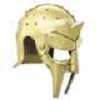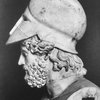 Constantine the Great
Constantine the Great
Constantine the Great (c. 272 – 22 May 337) was famed for winning the battle at the Milvian Bridge, reuniting the Roman Empire under one emperor (Constantine himself), winning major battles in Europe, legalizing Christianity, and establishing a new eastern capital of Rome at the city, Nova Roma, formerly Byzantium, that was to be named Constantinople.
Constantinople (now known as Istanbul) became the capital of the Byzantine Empire, which lasted until it fell to the Ottoman Turks in 1453.
 Spartacus Thracian
Spartacus Thracian
Born, Spartacus (c. 109 B.C.-71 B.C.) was trained in a gladiator school and led a slave revolt that was ultimately doomed. Through Spartacus’ military ingenuity, his men evaded Roman forces led by Clodius and then Mummius, but Crassus and Pompey got the best of him. Spartacus’ army of disaffected gladiators and slaves were defeated. Their bodies were strung up on crosses along the Appian Way.
 Themistocles
Themistocles
Themistocles (c. 524-459 B.C.) persuaded the Athenians to use the silver from state mines at Laurion, where new veins had been found, to finance a port at Piraeus and a fleet. He also tricked Xerxes into making errors that led to his loss of the Battle of Salamis, the turning point in the Persian Wars. A sure sign that he was a great leader and had therefore provoked envy, Themistocles was ostracized under Athens’ democratic system.
